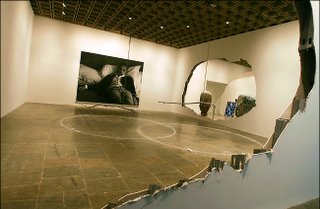 Urs Fischer's "Intelligence of Flowers" (holes in the wall) and "Untitled" (branches dripping candle wax). The painting in the background is, indeed, a painting.
Urs Fischer's "Intelligence of Flowers" (holes in the wall) and "Untitled" (branches dripping candle wax). The painting in the background is, indeed, a painting.(Can't quite believe that it's already been two years since the last one, which I loved--and that my life hasn't changed all that much since then.)
So anyway, this Biennial can be summed up, so: the art students across the hall got evicted, couldn't afford a mover, and left their discarded works-in-progress, plus all the furniture they picked up off the street, their collection of album covers, and a lot of random debris, piled up in the hallway.
The New York Times is only slightly more diplomatic about it:
This typically huge exhibition is very much an insider's affair, a hermetic take on what has been making waves. It will seem old hat to aficionados and inscrutable to many others...The whole ethos of the show is provisional, messy, half-baked, cantankerous, insular — radical qualities art used to have when it could still call itself radical and wasn't like a barnacle clinging to the cruise ship of pop culture.Old hat! Well, yes. Anyone who has been an artist and hung out with other artists will recognize the aesthetic--that of a chaotic, collective studio space inhabited by a bunch of poseurs under 30. There were very few of what I would call "finished works of art" in the show, and those were so badly hung, swamped by the mess around them, that they were difficult to find and harder to enjoy.
In fact, it was genuinely difficult to tell what was intended to be art and what wasn't. A chained-off corridor on the 5th floor stairwell had a bunch of old desks with office supplies on them, wrapped in packing tape, bearing Post-it notes that read, "Do Not Move Till March 2." In the stairwell between the 4th and 5th floors was a piece of discarded sheet rock, with the words "Holy Shit" in red spray-paint, upside down. My suspicion is that the first was debris and the second was art, but I could be wrong.
Very early on in my browsing, I started reading the text on the walls before looking at the 'art,' which should give you a rough idea of how unprepossessing the art was. In my view, a work of art has failed if it cannot provide any arresting aesthetic impact upon first viewing. In recent years, artists have been producing art that is like a Zen koan; a bunch of seemingly random objects, assembled in a way that produces no obvious functionality or coherent association of ideas, accompanied by ten pages of explanation nailed to the wall next to it.
When I go to Chelsea, I pop in and out of the galleries that show this stuff, faster than you can say "Jack Flanagan." Which means that I got through the Biennial in well under the three hours I'd allotted.
The curatorial statement, painted on the wall, explained the title of the show, "Day into Night." It discussed the ambiguous nature of Art Today, involving a continuous international dialogue among artists, the blurring of boundaries between traditional media like painting and sculpture and avant-garde stuff like video, installation and sound art. As the NYT points out, this sort of thing has been going on for quite awhile; long enough for some artists to have figured out their media and produced some focused, powerful, stunning work. Those artists were not included in this show.




No comments:
Post a Comment